Natsume Soseki
Light and dark
Introduction by John Nathan
 NATSUME SSEKI1 (18671916) endured the transformation of Japan, during the span of his lifetime, from a feudal society into a modern state modeled on Western blueprints and poignantly chronicled the emotional and intellectual turmoil that accompanied it, the paralyzing cost, in his words, of incurring a culture from the outside.2 Between 1905 and 1916, Sseki in Japan he is known by his pen name alone conveyed his bleak vision of life in thirteen novels, each one a giant step forward in his effort to elevate the fledgling Japanese novel to a level of observation that would make it true to life in the manner and degree of Western realism. A number of his early efforts were, as George Eliot might have said, more diagram than picture: characters are scantily revealed, and they step forward to deliver monologues that are thinly disguised lectures on themes he wants to promulgate. The narrator also intrudes didactically, delivering set speeches of his own. But book by book, Sseki is to be observed refining the art of his fiction, merging identifiably Japanese shades of indirection and reticence with the obtrusive approaches to inquiry he adapted from the Western novel. No other writer of the Meiji period (18681912) was so well equipped to achieve this synthesis: steeped in the Japanese and Chinese classics, an accomplished calligrapher and brush painter and a gifted haiku poet, Sseki was at the same time possessed of an impressive command of eighteenth- and nineteenth-century English poetry and fiction, particularly after two years in London, from 1900 to 1902, that he devoted to reading in English. His later novels are informed by his deep reading of Jane Austen, about whom he wrote at length, and of George Meredith and Henry James.
NATSUME SSEKI1 (18671916) endured the transformation of Japan, during the span of his lifetime, from a feudal society into a modern state modeled on Western blueprints and poignantly chronicled the emotional and intellectual turmoil that accompanied it, the paralyzing cost, in his words, of incurring a culture from the outside.2 Between 1905 and 1916, Sseki in Japan he is known by his pen name alone conveyed his bleak vision of life in thirteen novels, each one a giant step forward in his effort to elevate the fledgling Japanese novel to a level of observation that would make it true to life in the manner and degree of Western realism. A number of his early efforts were, as George Eliot might have said, more diagram than picture: characters are scantily revealed, and they step forward to deliver monologues that are thinly disguised lectures on themes he wants to promulgate. The narrator also intrudes didactically, delivering set speeches of his own. But book by book, Sseki is to be observed refining the art of his fiction, merging identifiably Japanese shades of indirection and reticence with the obtrusive approaches to inquiry he adapted from the Western novel. No other writer of the Meiji period (18681912) was so well equipped to achieve this synthesis: steeped in the Japanese and Chinese classics, an accomplished calligrapher and brush painter and a gifted haiku poet, Sseki was at the same time possessed of an impressive command of eighteenth- and nineteenth-century English poetry and fiction, particularly after two years in London, from 1900 to 1902, that he devoted to reading in English. His later novels are informed by his deep reading of Jane Austen, about whom he wrote at length, and of George Meredith and Henry James.

LIGHT AND DARK, Ssekis final novel, unfinished at the time of his death, began appearing in daily installments in the Tokyo and Osaka editions of the Asahi shinbun on May 16, 1916.3 It was the ninth novel he had serialized in the Asahi since he had contracted in 1907 to publish at least one novel a year in the newspaper in return for an annual salary substantially higher than his stipend as a senior lecturer at Tokyo Imperial University.4 A letter to an Asahi editor dated May 21 suggests that he had begun work on the novel a mere week in advance of the first scheduled day of serialization: I have been feeling poorly recently, in and out of bed, and apologize for my slightly delayed start with the new novel.5 The illness to which he stoically refers was the gastrointestinal malaise an infernal combination of intestinal catarrh, bleeding ulcers, and hemorrhoids that had plagued him his entire adult life. On June 10 Sseki writes to the same editor that he has mailed off installment 24; on that day installment 15 was published, indicating that he had managed to accumulate nine installments in advance of their serialization, a slim lead that he maintained until the final outbreak of his chronic condition overcame him on December 9.6
One can scarcely imagine the effort it must have cost Sseki to create a book as minutely observed and unsparing as Light and Dark in daily installments while suffering bleeding and intestinal pain that required him to bind his stomach with a belly band. Small wonder that he sought respite in Japanese brush painting and composing Chinese poetry in the afternoons from the demanding, largely unpleasant characters he was tethered to each morning. He makes reference to this in a letter dated August 21 to two of his disciples living in the same boarding house, Kume Masao, unknown to Western readers, and Akutagawa Rynosuke, whose sardonic short stories are well represented in translation:7
As before, I am at work on Light and Dark every morning. I feel a mixture of pain and pleasure but proceed as if mechanically. I am grateful above all for the unexpectedly cool weather. Even so, writing a thing like this every day, nearly one hundred installments now, leaves me feeling vulgarized. For several days I have been making it my business to work on Chinese poetry in the afternoons, assigning myself one poem a day if possible. Seven characters a line, not easy. But I quit when it gets hard so I dont accomplish that much.8
In a second letter written just days later, on August 24, he counsels the young writers to carry on doggedly with an analogy distinguishing a cow from a horse, an exhortation that was obviously addressed no less to himself:
Its necessary by all means to become a cow. Somehow or other we want to be horses; its not easy to become thoroughly a cow. Even a cunning old dog like me is scarcely more than the half-breed spawn of a horse and a cow.
You mustnt hurry. You mustnt muddy up your mind. Come out fighting and persist. In the face of persistence the world will bow its head; fireworks are accorded only an instants memory. Push hard until the end. Thats all there is to it. A cow proceeds phlegmatically with its head down.9
Toward the end of the summer, Ssekis physical decline becomes evident in the pages of his manuscript:10 his hand begins to waver, the characters grow fainter, and revisions scrawled between the lines increase conspicuously. Nonetheless, he was resolved to follow the novel wherever it should lead him, though increasingly troubled by his inability to conclude it. On November 16 he conveys his frustration to another disciple, studying in New York at the time, Naruse Seiichi: It troubles me that Light and Dark gets longer and longer. Im still writing. Im sure this will continue into the New Year.11
Sseki did not live to see the New Year. Too ill to write more, he took to his bed on November 21 after completing what was to be the final installment, number 188. He had intended to continue: a page of manuscript with the number 189 inked in the upper-right corner was found on his desk. In 188 installments745 pages in the first edition published by Iwanami Shoten the following year Ssekis final novel, though unfinished, was 200 pages longer than his next longest, the bitingly comic I Am a Cat (1905), and twice the length of anything else he wrote.
Light and Dark is unlike any of Ssekis thirteen antecedent novels, and entirely unlike anything else in Japanese fiction of the same period (or, for that matter, later periods). Thematically, it may be read as vintage Sseki: an exploration of the conflict between selfishness and love in which the victory inevitably goes to the former. What distinguishes and, indeed, qualifies it as perhaps the only work of fiction in twentieth-century Japanese literature that can be called a modern novel in the Western sense of the term is the degree of interiority it achieves. The protagonists, Tsuda Yoshio, thirty, and his wife, O-Nobu, twenty-three, are revealed at a depth that Sseki had never achieved in his previous work, and they emerge onto the page with a gratifying complexity that qualifies them as the first three-dimensional characters in Japanese fiction. If this is true of Tsuda, an emotional dullard (the critic Hirano Ken described him as a tsumarananb, a nonentity), it is startlingly true of O-Nobu. Coquettish but not exactly beautiful (Sseki alludes to her small eyes thirteen times), O-Nobu is quick-witted and cunning, a snob and narcissist no less than her husband, passionate, arrogant, spoiled, insecure, vulnerable, naive, idealistic, and, perhaps above all, gallant. Sometimes she reminds us of a Japanese version of Emma Woodhouse, or Gwendolen Harleth, or even Scarlett OHara (if one can imagine a less than ravishing Scarlett); in any event, under Ssekis meticulous scrutiny she emerges as a flesh-and-blood heroine whose palpable reality has no equal in other Japanese fiction.

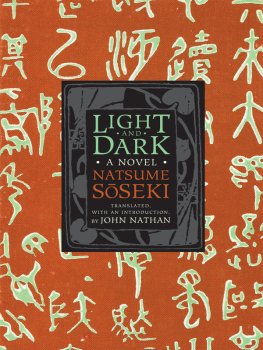
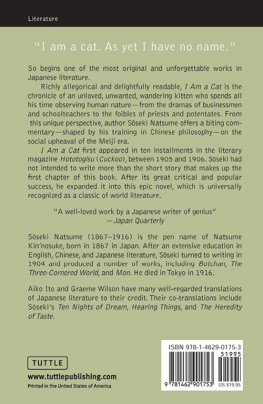
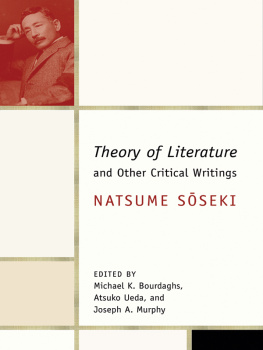
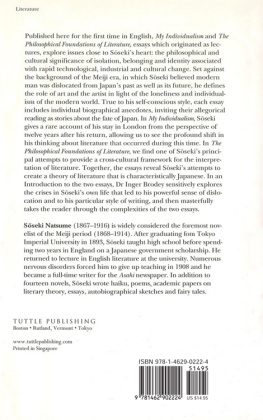
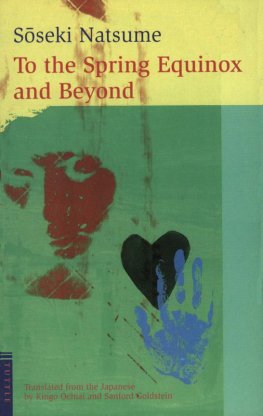
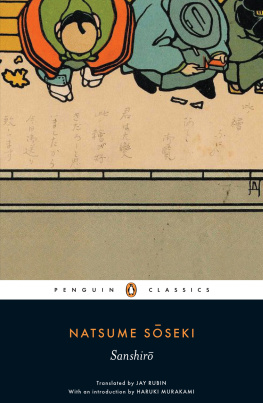



 NATSUME SSEKI1 (18671916) endured the transformation of Japan, during the span of his lifetime, from a feudal society into a modern state modeled on Western blueprints and poignantly chronicled the emotional and intellectual turmoil that accompanied it, the paralyzing cost, in his words, of incurring a culture from the outside.2 Between 1905 and 1916, Sseki in Japan he is known by his pen name alone conveyed his bleak vision of life in thirteen novels, each one a giant step forward in his effort to elevate the fledgling Japanese novel to a level of observation that would make it true to life in the manner and degree of Western realism. A number of his early efforts were, as George Eliot might have said, more diagram than picture: characters are scantily revealed, and they step forward to deliver monologues that are thinly disguised lectures on themes he wants to promulgate. The narrator also intrudes didactically, delivering set speeches of his own. But book by book, Sseki is to be observed refining the art of his fiction, merging identifiably Japanese shades of indirection and reticence with the obtrusive approaches to inquiry he adapted from the Western novel. No other writer of the Meiji period (18681912) was so well equipped to achieve this synthesis: steeped in the Japanese and Chinese classics, an accomplished calligrapher and brush painter and a gifted haiku poet, Sseki was at the same time possessed of an impressive command of eighteenth- and nineteenth-century English poetry and fiction, particularly after two years in London, from 1900 to 1902, that he devoted to reading in English. His later novels are informed by his deep reading of Jane Austen, about whom he wrote at length, and of George Meredith and Henry James.
NATSUME SSEKI1 (18671916) endured the transformation of Japan, during the span of his lifetime, from a feudal society into a modern state modeled on Western blueprints and poignantly chronicled the emotional and intellectual turmoil that accompanied it, the paralyzing cost, in his words, of incurring a culture from the outside.2 Between 1905 and 1916, Sseki in Japan he is known by his pen name alone conveyed his bleak vision of life in thirteen novels, each one a giant step forward in his effort to elevate the fledgling Japanese novel to a level of observation that would make it true to life in the manner and degree of Western realism. A number of his early efforts were, as George Eliot might have said, more diagram than picture: characters are scantily revealed, and they step forward to deliver monologues that are thinly disguised lectures on themes he wants to promulgate. The narrator also intrudes didactically, delivering set speeches of his own. But book by book, Sseki is to be observed refining the art of his fiction, merging identifiably Japanese shades of indirection and reticence with the obtrusive approaches to inquiry he adapted from the Western novel. No other writer of the Meiji period (18681912) was so well equipped to achieve this synthesis: steeped in the Japanese and Chinese classics, an accomplished calligrapher and brush painter and a gifted haiku poet, Sseki was at the same time possessed of an impressive command of eighteenth- and nineteenth-century English poetry and fiction, particularly after two years in London, from 1900 to 1902, that he devoted to reading in English. His later novels are informed by his deep reading of Jane Austen, about whom he wrote at length, and of George Meredith and Henry James.